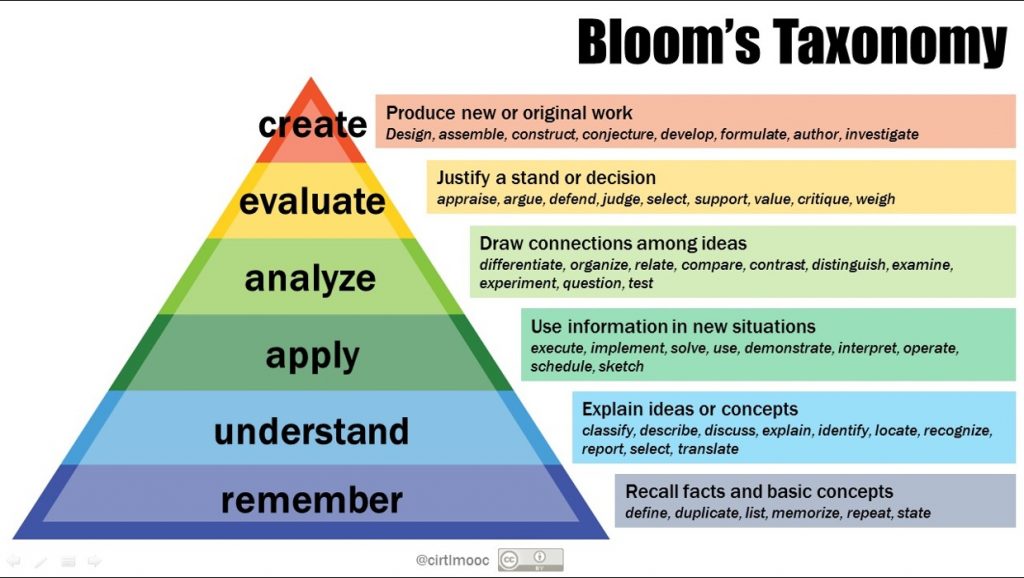Most educators realize that students’ success in school is less dependent on a couple of facts they know, and more dependent on the thinking skills gained while in school. One reason for this is the overflow of information that people receive. In 2000, 9.2 billion Google searches were made. In 2016, 9.02 billion Google searches were made…every day.
I don’t need to tell you that times are changing; frankly, if you don’t already know, I don’t want to shatter the illusion for you. This is why Bloom’s taxonomy, built in 1956, has even more prevalence today than it did when it was first presented. Long story short, it’s not about retaining facts anymore, it’s all about building foundational levels of expertise in certain subjects that can be tied to measurable student outcomes.
“Specific learning objectives can be derived from the taxonomy, though it is most commonly used to assess learning on a variety of cognitive levels.” The updated taxonomy is found below.

Why use Bloom’s Taxonomy?
-
- Establishing learning goals is important so students understand why they are in a certain course.
-
- Understanding foundations in business organization and culture is key as no two companies utilize the exact same structures.
- Having an organized set of objectives helps educators:
-
- plan and deliver instruction
-
- design assessment tasks and strategies
- ensure that instruction and assessment are aligned with the objectives
-
There are hundreds of websites explaining bloom’s taxonomy in more depth, but let me answer the question you really care about :
How can you utilize Bloom’s Taxonomy to build future leaders?
Almost every business or communications department has one of the following courses: Business Organizations, Strategy, Culture, or Leadership, as well as Human Resources. You can create a learning strategy for these courses that involves two parts, learning outcomes, which are assessed using Bloom’s taxonomy, and learning activities.
Keeping the purpose in mind will drive the course. For example, in Stukent’s Business Organizations and Culture textbook, the outcome of the course is to build foundational knowledge points that lead students to develop a business culture which allows them to execute business strategy.
The adapted Bloom’s taxonomy for the course focuses on 4 levels. From bottom to top, these are: Remember, Understand, Apply and Create. These levels are demonstrated in various quiz questions included in the course.
This is the “how” in the strategy. The activities involved in the learning strategy can include:
- Prepare (Review the outcomes of the chapter outlines, read/quiz/reflect/pre-assess, time investment)
- Engage (Interactive learning/sharing, real-world application through case studies)
- Assess (review/reflect/summarize, test students on the outcomes)
This learning strategy will increase student understanding, retention and development. Several learning resources can help improve the learning strategy (Yes, these are all included in the Stukent course).
-
- Faculty Notes-These are given to faculty to improve their preparation and limit some of the demands on their time.
-
- Student Preparation Notes-The student is given an overview of each chapter, outcomes, discussion questions, and case-study questions along with a general chapter outline.
-
- Learning Outcomes-This is the take away for the course; “What should a student know and be able to do.”
-
- Case Studies– These are current, real-world case studies. The format is one to two pages in length with questions for students and explanations for faculty to use in discussions.
-
- Video Clips– These are current clips that apply to topics. Faculty notes are included.
-
- Test/Quiz Banks-Each chapter includes questions that are based on a taxonomy of 4 levels; recall, understanding, application, expansion (transfer, connect and create). They can be used for quizzes and tests.
-
- Discussion Questions– These relate to outcomes for the chapter and will provide assessment at the formative level on how well students are learning.
-
- Knowledge Notes-This is a tool that can be used to help students prepare, assess and remember. Faculty can use these for discussion, focus and a summary of key materials.
-
- PowerPoint Slides-The slides are focus points that can be used for class lecture, discussion and review. They were prepared to help students and faculty have a visual opportunity for learning.
- Team Exercises– A major part of the learning strategy is an engaged class time. The use of small groups engages the learner in the learning process. Templates are given that can focus on teams arriving at an application level. This tool can be for engagement before class, during class and after class.
The taxonomy is hierarchical, so learning at higher levels is dependent on the knowledge and skills gained at lower levels. However, this doesn’t mean that foundational levels of the taxonomy need to be understood in order to assess on higher levels. Instead, it’s important to understand the ultimate level of understanding the students should reach. For example, a freshman-level course might not need to reach the highest level in the taxonomy, but hopefully a junior or senior level course would.
As students are presented with the idea of how to learn versus what to remember (and probably forget) they will be able to apply concepts of business culture, strategy and organization to their future careers. With practice from real-world case studies and assessments that measure their understanding, professors can build future business leaders. They can help students help the world.
Have you had success with this teaching style? Let us know in the comments or tweet @nicole_call1
Want to see the strategy in action? Request free instructor access to the course today!
[button shape=”square” size=”large” float=”none” href=”https://www.stukent.com/business-writing-textbook/” info=”none” info_place=”top” info_trigger=”hover”]GET FREE ACCESS[/button]






